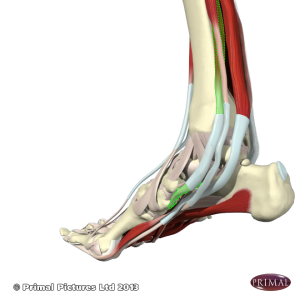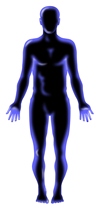Tenoperiositis of the Shin/ ‘Shin Splints’
What is it?
Tenoperiositis of the shin, or ‘shin splints’, refers to inflammation occurring where tendons or muscles attach to the shin bone, the tibia.
Shin splints results from overuse. Tendons and muscles attach to bone via a layer of connective tissue overlying the bone. This tissue is called the periosteum. When muscles contract they pull on their tendons, which in turn pull on the periosteum overlying the bone. With overuse, poor lower limb biomechanics (alignment) or increased muscle tightness this pulling can damage the periosteum. This results in an inflammatory response as the body attempts to repair the damage. Consequently, tenoperiositis is inflammation (-itis) where a tendon (teno-) attaches to the periosteum (-periost-).
Overuse typically occurs when the volume of exercise increases too quickly for the tissues to be able to cope. It is important that when you increase your volume of exercise you do so gradually so that your body is adequately able to adapt to the loads place on it.
How does it feel?
Shin splints is typically felt as pain along the inside border of the tibia, above the inside part of your ankle. It is usually painful as you begin exercise, however, as the area begins to ‘warm-up’ the pain may subside. With long sessions of exercise or following exercise, your pain may gradually return. The painful area may be tender to touch. You may also feel tight or thickened bands of tissue on the inside part of the shin.
What should you do?
Shin splints generally does not settle on its own if the cause is not addressed and you continue to exercise with the problem. If you suspect that you have shin splints then you should consult with us at Life Fit. In the meantime you can begin initial treatment. This should consist of resting from painful activities, self-massage of any tight and thickened tissues and regular periods of icing to the painful area. An effective way to ice this area is to freeze water in a paper cup and massage the exposed end up and down the inside of the shin for 5 to 10 minutes at a time.
What shouldn’t you do?
If you think you have this problem then you shouldn’t ignore it. The pain may get better as you exercise, however, the exercise you are doing may be causing further damage. This can lead to the injury getting worse so that it doesn’t ‘warm up’ and you feel it through an entire exercise session.
Could there be any long-term effects?
Shin splints do not normally produce any long term effects as long as the condition is properly diagnosed and appropriately treated. Symptoms can continually recur if the cause of the problem is not addressed.
Management
The assistance of a sports medicine professional is important in the treatment of shin splints. Initially they will assist with diagnosing the problem and establishing its severity. Following this an appropriate treatment plan will be developed. This may involve advice to modify the type or volume of exercise that you are doing, soft tissue treatment such as massage and the correction of any biomechanical abnormalities. It may be recommended that you see a sports podiatrist if there are issues with your foot alignment. A sports medicine professional should be able to determine why you developed shin splints in the first place and address this during your recovery to prevent recurrences in the future.
Disclaimer: This information is not a substitute for medical advice and you should seek professional advice from a doctor, physiotherapist or other healthcare professional.






